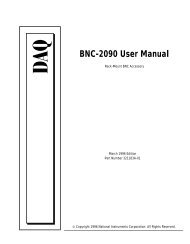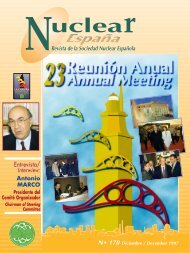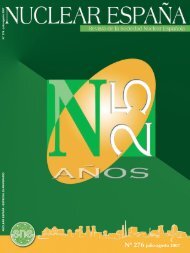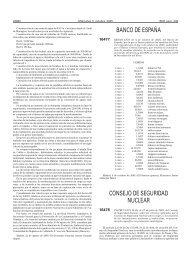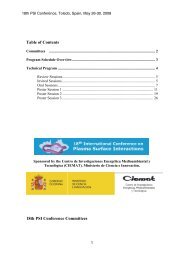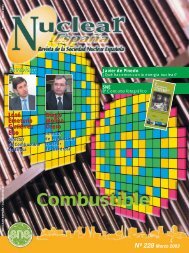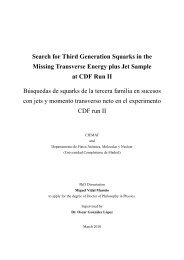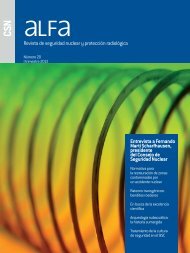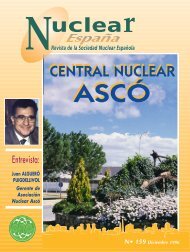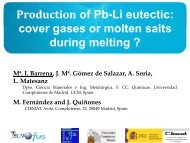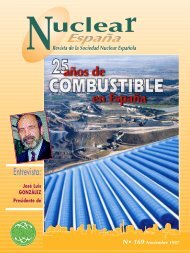EntrEntr evista/evista/ InterInter viewview
EntrEntr evista/evista/ InterInter viewview
EntrEntr evista/evista/ InterInter viewview
Create successful ePaper yourself
Turn your PDF publications into a flip-book with our unique Google optimized e-Paper software.
CENTRALES NUCLEARES/NUCLEAR POWER PLANTS<br />
nos encontramos con dos unidades<br />
y en la otra una. A continuación<br />
hay que estudiar en profundidad<br />
cuáles son aquellas organizaciones<br />
de las centrales que estando en una<br />
de ellas pudieran atender a las dos.<br />
Por ejemplo, la vigilancia de estructuras<br />
de Ascó sirve, de hecho está<br />
utilizándose, y ya está hecha la<br />
prueba integrada de contención para<br />
las dos centrales. Hay otras organizaciones<br />
que se están estudiando<br />
cuidadosamente, como el análisis<br />
específico de aquellas partes que<br />
son compartibles. Por ejemplo, es<br />
compartible un almacén virtual único,<br />
es decir, como partimos de dos<br />
almacenes físicamente distribuiremos<br />
los repuestos más apremiantes,<br />
los específicos, quizá en cada una<br />
de las centrales, pero el tratamiento<br />
de la gestión y el tratamiento informático<br />
es como un almacén único.<br />
En las plantas hay una larga dilucidación<br />
sobre procesos a compartir,<br />
por ejemplo, dentro de la PR, la<br />
gestión medioambiental y de calibración.<br />
Todo este proceso constitutivo<br />
tiene que tener evidentemente<br />
un techo de cristal con el Consejo<br />
de Seguridad Nuclear, nuestro órgano<br />
regulador.<br />
Sobre todo, lo importante es tener<br />
un equipo de colaboradores que estén<br />
comprometidos e involucrados<br />
y que trabajen en equipo. Si todas<br />
las misiones empresariales son labor<br />
de equipo, en el caso que nos ocupa<br />
lo es en grado sumo. Lo es en el<br />
caso de una central nuclear y en el<br />
caso de una integración entre centrales<br />
lo es aún más.<br />
ACUERDOS CON<br />
LA REPRESENTACIîN SOCIAL<br />
Necesitábamos encontrar una salida<br />
ordenada de personal que fuera<br />
voluntaria, que tratara de compaginar<br />
la libertad y los derechos individuales<br />
laborales con los derechos,<br />
las necesidades y las obligaciones<br />
de la empresa. Esto se resolvió con<br />
discusiones con los dos comités con<br />
los que estamos negociando, correspondientes<br />
a las dos asociaciones, a<br />
través de una capacidad de retención<br />
de hasta cinco años. Esto nos<br />
permite una movilidad y también la<br />
promoción de personal. Tenemos la<br />
ventaja de que nuestras plantas y<br />
nuestro régimen laboral nos proporciona<br />
un régimen laboral hiperestable,<br />
pero muchas veces esta hiperestabilidad<br />
puede ser frustrante si<br />
no se compesa, como se trata de<br />
hacer en todas nuestras organizaciones.<br />
Evidentemente estamos hablando<br />
de un relevo generacional parcial.<br />
La duración de esta regulación es<br />
de 5-6 años, si bien hay que decir<br />
que la parte decisiva son los tres<br />
primeros años. Los aspectos principales<br />
son el mantenimiento de los<br />
recursos claves existentes y la transmisión<br />
ordenada de conocimientos<br />
y habilidades. Los conocimientos<br />
son mucho más fáciles de transmitir<br />
que las habilidades (la experiencia,<br />
las actitudes y la cultura de seguridad).<br />
¿Cómo la operativizamos?<br />
Nosostros tenemos un proyecto que<br />
llamamos AVE. La movilización de<br />
generosidad individual es una de<br />
las claves de procesos como éste.<br />
Cuando uno se encuentra con dos<br />
organizaciones maduras, autosatisfechas,<br />
con una ejecutoria muy<br />
aceptable, evidentemente han producido<br />
dos culturas técnicas empresariales<br />
y sindicales próximas pero<br />
distintas.<br />
Ante la intensidad de objetivos en<br />
el tiempo es importante formentar y<br />
establecer lo más objetivamente<br />
que se pueda elementos de autocrítica,<br />
elementos de control, semáforos.<br />
CONCLUSIONES<br />
Ya hemos entregado a las representaciones<br />
sociales toda la documentación<br />
administrativa mercantil<br />
para proceder a la fusión de las dos<br />
asociaciones, con el fin de trabajar<br />
con una sola AIE. Naturalmente<br />
tendremos que administrar las tres<br />
comunidades de bienes, que son<br />
cada una de las tres unidades, porque<br />
Ascó tiene dos porcentajes distintos.<br />
Estamos administrando desde<br />
el punto de vista mercantil cinco<br />
empresas, dos AIES y tres comunidades<br />
de bienes. A partir de ahora<br />
vamos a administrar una AIE con<br />
tres comunidades de bienes, pero a<br />
través de la AIE. Confiamos que esto,<br />
con el sistema económico SIE<br />
2000 que hemos preparado, nos<br />
alivie de uno de los aspectos que<br />
representa más carga de trabajo administrativo.<br />
Cuando se tienen tantos objetivos,<br />
es muy importante establecer,<br />
en primer lugar, una plasmación de<br />
estos objetivos, de este acuerdo, de<br />
esta comunicación y de este diálogo<br />
con las propiedades, y nosostros<br />
lo hemos plasmado en un plan estratégico,<br />
que es el reflejo de estas<br />
directrices, diálogo, comunicación<br />
con las propiedades. Este plan estratégico,<br />
a nuestro modo de ver,<br />
reflections is the importance of accepting the tempo<br />
of everything involved in these processes. The<br />
process of analyzing the two maintenance<br />
approaches is a necessarily slow process in reaching<br />
maturity – it is an in-depth process. One of the most<br />
important issues is to find the tempo of each of the<br />
aspects involved in this type of integration.<br />
The basic concepts of the organization are: to<br />
have a common management, to have service<br />
divisions common to both plants and, as regards the<br />
plants themselves, to have a structure that is as<br />
homogeneous as possible to facilitate synergies. This<br />
does not mean that it should be a totally cloned<br />
structure, because in one plant we have two units<br />
and in the other one unit. An in-depth study must<br />
thus be made of those plant organizations that, while<br />
located in one plant, can serve both. For example,<br />
structural monitoring in Ascó is one of these and in<br />
fact is being used, and the integrated containment<br />
test for both plants has already been completed.<br />
There are other organizations that are being carefully<br />
evaluated, such as specific analysis of parts that can<br />
be shared. For example, a single virtual warehouse is<br />
shareable, i.e., since we have two warehouses we<br />
will perhaps physically distribute the most urgent,<br />
specific parts in each of the plants, but management<br />
and computer processing will be done as if we had<br />
a single warehouse. Considerable consideration is<br />
being given in the plants to the processes to be<br />
shared, for example within PR, environmental<br />
management and calibration. This whole<br />
constitutive process must obviously be linked to the<br />
Consejo de Seguridad Nuclear, which is our<br />
regulatory body.<br />
Above all, it is important to have a group of<br />
committed, involved collaborators working as a<br />
team. If all business missions require teamwork, in<br />
our case it does so even more. It is important for a<br />
nuclear plant, and even more important when<br />
integrating plants.<br />
AGREEMENTS WITH THE SOCIAL PARTNERS<br />
We needed to find a way to provide for the<br />
voluntary, orderly departure of personnel, which<br />
would reconcile individual labor rights and freedom<br />
with the rights, needs and obligations of the company.<br />
This was resolved in discussions with the two<br />
committees of the two associations that we were<br />
negotiating with, through a power of retention of up to<br />
five years. This gives us mobility and also allows us to<br />
promote personnel. We have the advantage that our<br />
plants and our labor system are super-stable, but this<br />
super-stability is often frustrating if it is not<br />
compensated, as all our organizations are trying to do.<br />
Obviously we are referring to a partial<br />
generational changeover. This staff regulation will<br />
last 5-6 years, although the most decisive period will<br />
be the first three years. The main points are<br />
maintaining existing key resources and the orderly<br />
transfer of know-how and expertise. It is much easier<br />
to transfer know-how than expertise (experience,<br />
attitudes and the safety culture).<br />
How do we make this work? We have a project<br />
that we call AVE. Mobilizing individual generosity is<br />
one of the keys to processes such as this one. When<br />
there are two mature, self-satisfied organizations<br />
with a very acceptable record of execution,<br />
obviously there will be two close but distinct<br />
technical cultures – enterprise and trade union.<br />
In view of the numerous objectives to be<br />
achieved, it is important to promote and establish as<br />
objectively as possible certain elements of selfcriticism<br />
and control.<br />
CONCLUSIONS<br />
We have already delivered to the social partners<br />
all the administrative-commercial documentation for<br />
proceeding with the merger of the two associations,<br />
A b r i l 2 0 0 0<br />
R e v i s t a S N E




